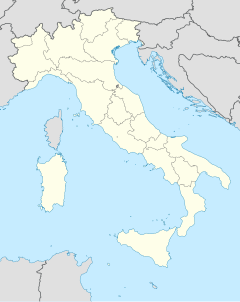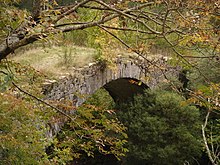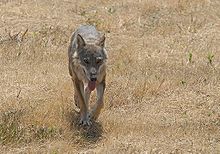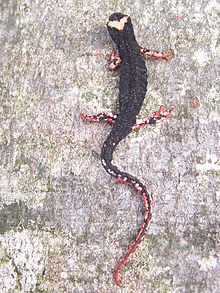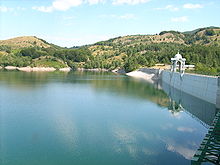Aveto Regional Natural Park
| Aveto Regional Natural Park | ||
|---|---|---|
| The Monte Groppo Rosso in the Aveto Regional Nature Park | ||
|
|
||
| Location: | Genoa , Italy | |
| Next city: | Genoa | |
| Surface: | 30.18 km² | |
| Founding: | 1995 | |
| Address: | Via Marré, 75a 16041 Borzonasca (GE) Tel. 0185/340311 |
|
The Regional Nature Park aveto ( Parco Naturale Local dell'Aveto ) is a standing protected Regional Park in the Italian Metropolitan Genoa in Riviera . It was founded in 1995 and covers areas of the municipalities of Santo Stefano d'Aveto , Rezzoaglio , Borzonasca , Mezzanego and Ne for a total of 3,018 hectares.
The park is located in the most biologically important section of the Ligurian Apennines . With the establishment of the nature park, the geological diversity and the biodiversity of flora and fauna are to be preserved. Last but not least, the finds of the first ancient settlements in this area are to be protected.
Specifications
The area of the park (3,018 hectares ) is divided into the following areas:
- General, directed reserve ( Riserva Generale Orientata , RGO): 1,340 ha
- Protected area ( Aree di Protezione , AP): 1,606 ha
- Development area ( Aree di Sviluppo , AS): 45 ha
- Natural monument ( Monumento Naturale , MN): 27 ha
The subdivision of the nature park is intended to enable greater efficiency in terms of protection and development support, with maximum visitor capacity. In the Riserva Generale Orientata , nature should be able to develop, but is guided into a certain landscape form under human supervision. For example, in this area the advance of a certain type of plant is stopped in order to preserve the original landscape. Intervention in the nature of this reserve section is permitted for this purpose alone.
In contrast, the Monumento Naturale only places a very specific natural element and its immediate environment under protection. Such natural elements have "a specialty or uniqueness value due to their inherent rarity, their representative and aesthetic qualities or because of their cultural significance". Natural monuments of the Aveto Regional Nature Park are, for example, the giant sequoia of Allegrezze and the beech Faggio 40 .
The Aree di Sviluppo are characterized by a landscape worthy of protection, in which buildings (historical settlements, castles, churches, etc.) of particular interest are integrated. In this area there are often information and service facilities for visitors. The Aree di Protezione , on the other hand, encompass areas of the park that are characterized by human presence. Here you will find smaller villages and agricultural areas of particular historical or scenic value.
In general, it should be mentioned that the specific subdivision of the regional park surfaces into different types of protection is not uniform in Italy and national standardization is still pending.
The park administration is located in the municipality of Rezzoaglio. The President of the Aveto Regional Nature Park is Giuseppino Maschio ( Commissioner for the Borzonasca Municipality). The park maintains a partnership with the Swiss Parco Gole della Breggia .
history
The region around the nature reserve has a very old history from an anthropological point of view. The oldest human traces are around 7,000 years old (corresponds to the Mesolithic ). They date from the time when the regional tribes from the valleys expanded their hunting grounds to the high altitude areas of today's protected area, which are rich in game, and began to keep grazing animals on a larger scale. Due to the deforestation of the fir forests that became necessary for this, beech trees were able to gain a foothold, which gradually displaced the conifers due to favorable climatic conditions. Because of the great willingness of the Ligurians to fight, the area was difficult to colonize by the Romans.
The first documents relating to the region of today's park date back to the Middle Ages . They deal with questions relating to the development and donation of property. Around the year 1000, the monks of San Pietro in Ciel d'Oro began teaching the gospel and farming techniques to the local population . In addition, they upgraded the region with the reclamation of some areas and the creation of numerous plantings. After the valleys were under the control of various feudal lords (the Malaspina , De Mileto and the Fieschi ) for a long time , in 1797, with their suppression, the territory of the Republic of Genoa was granted. During the Risorgimento, the region suffered the same fate as the city of Genoa, and subsequently that of unified Italy.
During the Second World War , the valleys of today's nature park were the scene of bitter partisan fighting. After the partisans initially used the mountains as a retreat, towards the end of the war they pushed further and further against the villages in the coastal areas.
In 1995, the natural park was founded with the regional law number 12/1995 under the official name Parco Naturale Regionale dell'Aveto . Since then, no changes have been made to the park boundaries.
The valleys of the park
The area of the nature park is criss-crossed by three morphologically very different valleys.
The Avetotal
The Aveto Valley (Val d'Aveto) , formed by the river of the same name, is enclosed by some of the highest mountains in the Ligurian Apennines: Monte Maggiorasca (at 1804 meters the highest mountain in the metropolitan city of Genoa ), Monte Penna (1735 meters), Monte Groppo Rosso (1593 meters) and Monte Aiona (1701 meters). The valley is characterized by highlands with numerous pastures in the middle of extensive beech forests. Cattle breeding in the Aveto valley has had a lasting impact on the landscape.
The valley is an important travel destination in the back country of Tigullio , in summer because of the cool climate, in autumn for mushroom picking and in winter for skiing ( cross-country skiing , alpine skiing and touring skiing ). The valley is formed by the Aveto river and many short tributaries, most of which have the character of a torrent; the largest of them is the Gramizza stream .
The Sturlatal
In the Sturlatal (Valle Sturla) mainly chestnuts grow on the upper reaches of the Sturla, followed by nut and olive trees. Pastures and vegetable gardens can be found between these. The Sturlabach flowing through the valley flows into the Lavagna brook near the sea . The valley thus has a great variety of landscapes over a few kilometers: both springs and mountain landscapes, as well as climatically milder, coastal landscapes, with gentler hills and plains on the lower reaches. The Sturla , after which the valley is named, has been used to generate electricity for a long time.
The Graveglia Valley
The Gravegliatal (Val Graveglia) has the most interesting history of all three valleys. The character-giving geo- and rock formations have enriched the soil with minerals, which enabled the creation of a special environment, as the specific nutrients promoted vegetation that stood out from the Ligurian landscape.
At the same time, the ancient human influences on this environment become clear. There are numerous quarries and mountain tunnels in the valley, in which raw materials have been extracted for many years. The Val Graveglia is the destination of many geologists and speleologists , but also many tourists. Traditional products made from olives, grapes, chestnuts and vegetables as well as small characteristic villages from old times have been preserved in the rural surroundings. The Gravegliabach , which gives it its name , also flows into the Lavagna and has the Reppia as its largest tributary .
flora
Thanks to its great variety of soils, landscapes and microclimates, the park has a diverse flora.
Over the centuries, agriculture and animal husbandry have greatly changed the image of the three valleys. In the park there are numerous artificially created meadows, pastures, terrace cultures , chestnut forests and hazelnut plantations . In the forests you can find beeches , oaks and manna ash, as well as willow and alder along the waterways .
In the park there are some trees that according to the Regional Law No. 4/1999 on natural monuments have been declared: the Cypress of Borzone and the chestnut of Poggio (near Borzonasca) that Flaumeiche of Gòsita (municipality Ne), the giant sequoia of Allegrezze ( Municipality of Santo Stefano d'Aveto) and the beech of Monte Zatta (also called Faggio 40 , near the municipality of Mezzanego).
39 endemic species can be found on the territory of the Aveto Park (although the endemism of most species extends beyond the park boundaries, mostly to the neighboring regions of the Alpine and Apennine mountains), including the primrose Primula microdonta , the Alpine columbine ( Aquilegia alpina ), the devil's claw Phyteuma serratum , the Aster family Robertia taraxacoides and Salzmann's broom ( Genista salzmannii ). There are also a large number of plant relics from the Ice Age . Examples are the Alpine winter fern ( Woodsia alpina ), various types of peat moss ( Sphagnum ), the Austrian chamois ( Doronicum austriacum ), the Apennine anemone ( Anemone apennina ), the marsh marigold ( Caltha palustris ), the two-flowered violet ( Viola biflora ) and the carnivorous round-leaved sundew ( Drosera rotundifolia ) is mentioned.
The shrubs in the park include a. the boxwood . Together with the rare border fern ( Cheilanthes marantae ), it populates areas with serpentinite rock, which many plant species avoid due to the high magnesium and chromium content. This vegetation is most pronounced on Monte Bossea , which is almost covered by a “scrub forest” ( maquis ).
fauna
The vast forests of the territory have enabled a high level of biodiversity both in the past and in the present . The fauna of the park is typical of the Apennines . The species of greatest tourist interest are certainly the Apennine wolf and the red deer . After nearly becoming extinct in the region, both settled back in the park and are the only representatives of the larger mammals in the reserve.
Mammals
The wolf has only recently repopulated the region. Due to the protected areas and retreat areas in the partially inaccessible Apennines, the population has recovered strongly and is also beginning to expand into the Alpine region . The return of the wolf depends heavily on the deer population in the region, which is the main prey. In recent years more attempts have been made to relocate deer to the Aveto area in order to strengthen the natural balance. Wild boars , foxes , stone marten and squirrels can be found in large numbers in the park . Badgers , polecats and hares are less common . The park's small mammals include dormice , moles , hazel , snow , field and voles .
Birds
The birds of greater importance are the golden eagle , the hawk , the short-toed eagle , the kestrel and the buzzard . In addition, redstart , rock tern , chaffinch , wagtail , goldfinch , jay , hoopoe , cuckoo and thrush can be found in the park . In total, more than 60 bird species nest in the Aveto Park area. The diversity of the bird world is favored by the large number of different microclimates .
Amphibians and fish
The amphibians in the Aveto Regional Nature Park include spectacled salamanders (which are endemic only in the Apennine Mountains), cave salamanders and common frogs . The many wetlands and watercourses with the best water quality promote the reproduction and spread of the amphibians. The good water quality is indicated by the presence of jackdaws , which can only reproduce in the purest of waters.
geology
The current landscape of the nature park is a result of larger tectonic movements, in connection with the orogeny of the northern Apennine mountains, and subsequent glacial formations in the Quaternary , which created a group of small, intramorainic glacial lakes . The Monte Aiona and the Monte Penna consist mainly of ophiolite rock , which originally formed the basalt bed of an ocean basin (Ligurian-Piedmontese primeval ocean of the Tethys ) of the Mesozoic era .
To illustrate the geological features of the park, two Ophiolitic circular hiking trails ( signposted as Sentiero Ofiolitico in the park) have been set up around Monte Cantomoro . Another karst hiking trail (Sentiero Carsologico) near Arzeno leads the visitor to the most distinctive karst formations of the territory.
Of the greatest geological interest, however, is the Graveglia Valley with its numerous rock formations of various types and origins. The rock types include limestone , jasper , various clay minerals and sandstones . The latter often occur as sedimentary rocks in connection with ophiolite rocks .
The occurrence of various manganese compounds has led to brisk mining activity in the past. The most important minerals are braunite , reppiaite , tinzenite and calcite . The only manganese mine still producing today is the Miniera di Gambatesa . It is one of the most important manganese-producing mines in Europe and some of it has been opened to the general public.
A geomorphological feature of the park is the Doline di Pian d'Oneto , a large basin with grass and swamp areas and an active sinkhole .
Wetlands
There are many wetlands with different biotopes and ecosystems on the grounds of the park . As already mentioned, numerous streams flow through the valleys, the good water quality of which is indicated by the presence of jackdaws. A special feature of the park are the many small glacial lakes that are located in the depression between Monte degli Abeti and Groppo Rosso . Here some time ago glaciers had created hollows that now form the wetlands. The formation of the lakes was also favored by the relative impermeability of the rock strata and by the moraines forming the dams . A number of small lakes were thus able to form, which provide a habitat for amphibians and aquatic plants and which were the reason for the establishment of the Riserva Naturale Orientata delle Agoraie .
Another interesting wetland is the Lago di Giacopiane , an artificially created lake from the 1920s that is used to generate electricity.
Attractions
nature
Among the sights that the nature of the park has to offer are the glacial lakes and the Lago di Giacopiane (also Laghi di Giacopiane ). Among the first is the Lago delle Lame (German: Klingensee ), which is located in the forest of the same name. The man-made Lago di Giacopiane is also surrounded by the park's forests.
The Monte Penna , at 1,735 meters the second highest mountain in the park, stands out for its extraordinary rock formations. From the top of the mountain there is a unique view over the Po plain to the Alps in the north and over the Apennines to the Ligurian Sea in the south.
Also noteworthy is the beech forest of Monte Zatta , which is considered one of the most beautiful beech forests in Liguria. The largest tree in the forest (called Faggio 40 ), weakened by a strong fungal attack, fell victim to a storm, but it can still be admired in its full size (even if it has been felled).
Cultural
One of the sights from Ligurian culture and history is the Borzone Abbey , which was built according to an inscription in 1244. However, scientific research suggests that it was built in the 7th century. The abbey is in the Borzonasca commune and was built on a small hill.
In order to commemorate the formerly important mining in Val Graveglia , a project to redevelop and restore the numerous mine tunnels in the valley was launched. There is also a mineral museum in Reppia .
The castle of Santo Stefano d'Aveto was built in 1164 by the Malaspina family to monitor the Po plain. It was recently restored and can be visited.
Transport links
The municipalities of the park are not directly connected to motorway tollbooths, i.e. motorway exits. However, the southern part of the nature park can be reached from the A12 coastal motorway via the Chiavari (from Genoa) and Lavagna (from La Spezia ) exits. The same applies to the rail network (Chiavari and Lavagna stations).
The following provincial roads (Strade Provinciali - SP) can be used within the park :
- SP 586 (SP 568 della Val d'Aveto)
- SP 26 (SP 26 to del Passo del Bocco)
- SP 654 (SP 654 della Val di Nure)
- SP 56 (SP 56 di Barbagelata)
- SP 23 (SP 23 della Scoglina)
Hiking trails
A section of the Alta Via dei Monti Liguri (high hiking trail of the Ligurian Mountains) runs through the park in an east-west direction . There are also numerous other hiking trails in the nature park, most of which, with excellent views, run around the mountains in a ring shape. The most famous circular routes are those of Monte Bossea , Aiona , Zatta , Ramaceto and Penna .
Sports and other activities
The nature park also offers numerous recreational opportunities, although hunting is of course prohibited. The most popular sports are:
- Skiing (alpine skiing, cross-country skiing and touring skiing on the higher mountains),
- Trekking on trails of varying difficulty,
- Mountain biking on the above mentioned trails,
- but also riding, mountaineering, canoeing, fishing and activities in the numerous caves and grottos.
The park operator also offers some teaching activities. For example, theme-specific tours through the park and courses on environmental education take place. A library with an attached documentation center is also located in the premises of the park administration in Rezzoaglio . Its book inventory includes 1000 copies of non-fiction books on the subject of the environment and nature. Special focuses are: local history and culture, geography and geology, agriculture and the flora and fauna of the nature park. One section is specially dedicated to younger park visitors. The library is generally accessible on request.
gallery
swell
- ↑ www.parks.it
- ↑ Thesis: "Parchi E Aree Protette: Una Classificazione"
- ^ Rivista del Coordinamento Nazionale dei Parchi e delle Riserve Naturali Giugnio 1995
- ↑ http://www.parks.it/parco.antola/pun.html
- ↑ http://www.parks.it/parco.aveto/par2.html#Storia
- ↑ Le sequoia di Allegrezze: ricordi e tracce di emigranti tornati dall'America (Italian / English / French)
- ↑ Laghi Di Giacopiane (Italian)
- ↑ Hiking trails in the park (German)
- ↑ Newsletter: Nel Parco - Notice ed attività per tre mesi nel Parco dell'Aveto
- ↑ http://www.parks.it/parco.aveto/ser.html
See also
Web links
- Pages of the parking authority on Parks.it
- Val d'Aveto (Italian / English / French)

